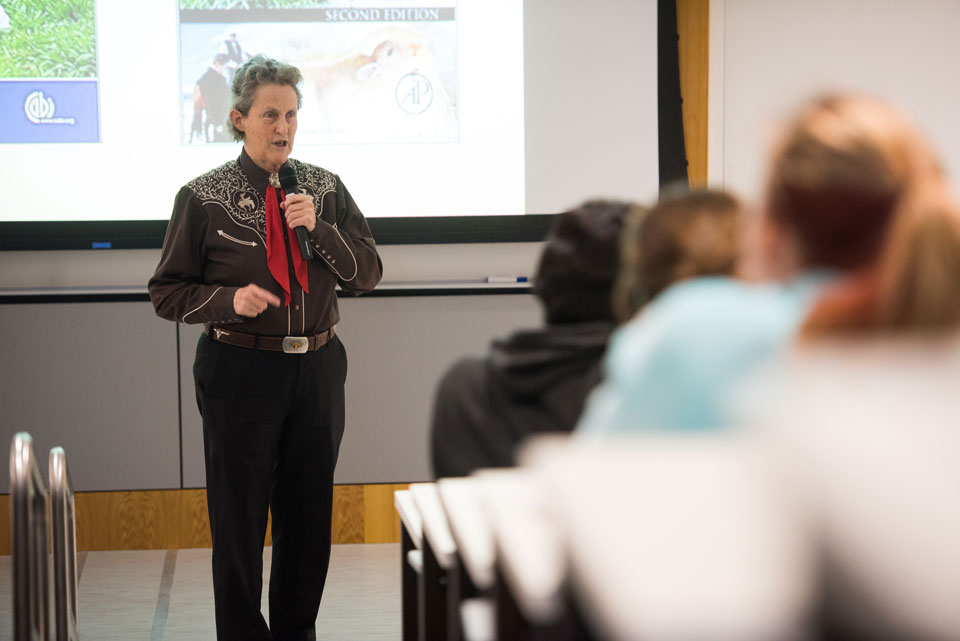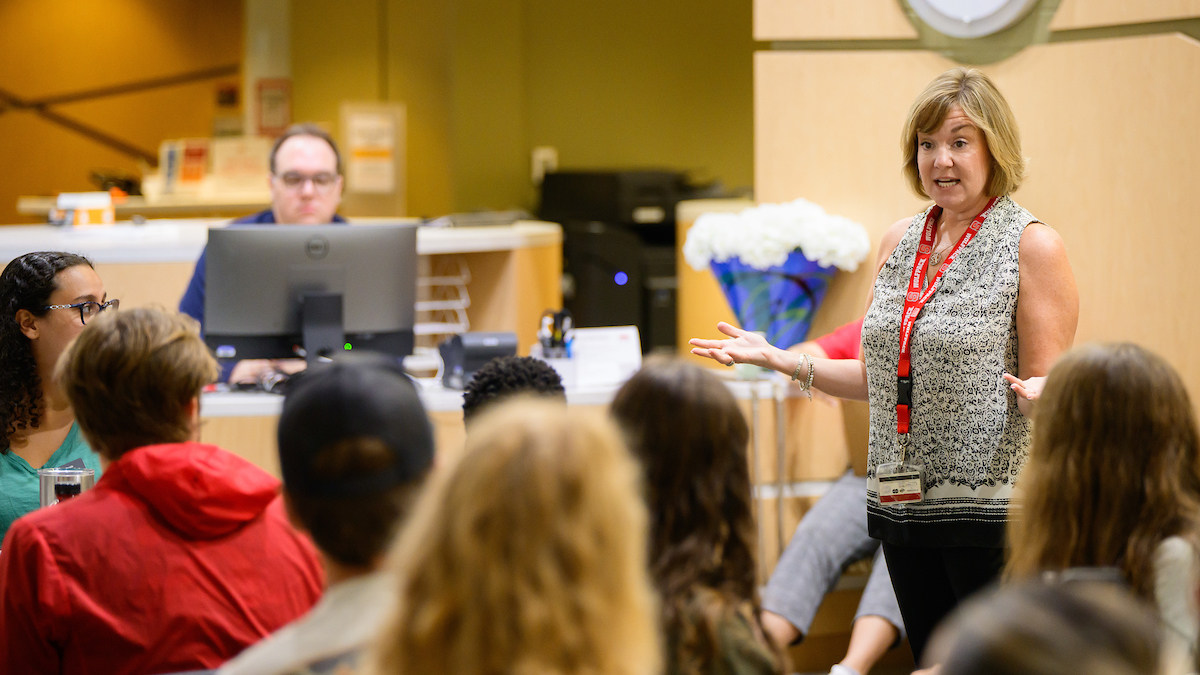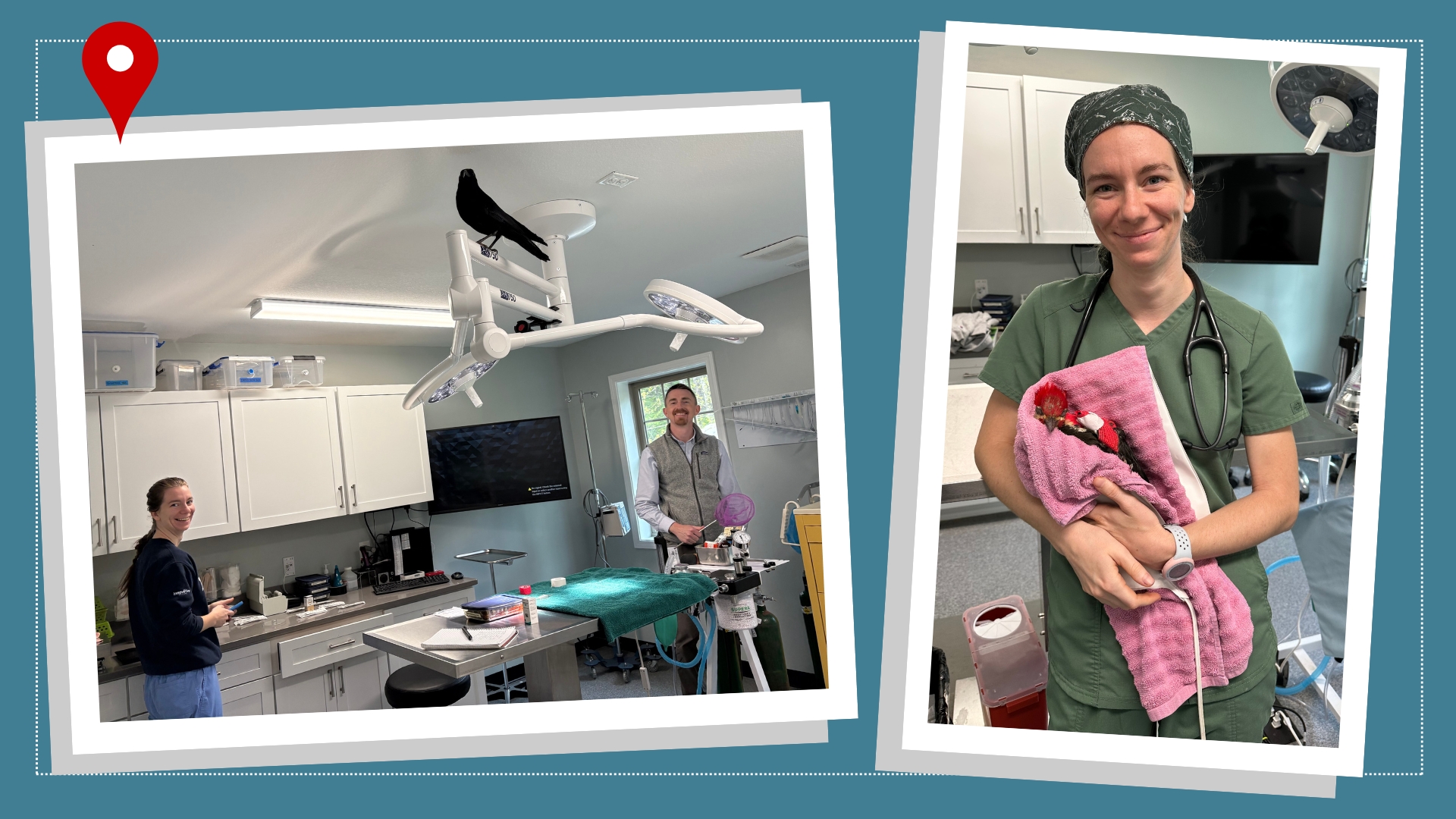To CVM Students, Grandin Stresses Understanding Animal Behavior

In veterinary behavioral medicine, little things provide great insight.
Tail swishing is a sign a cow may not be that happy. A specific color of a hat may bring back memories of a traumatic incident for a horse. But seeing soft brown eyes in cows or horses? That’s a good sign. Seeing the white of their eyes? Not so much.
In an irreverently insightful lunchtime lecture on Tuesday, world-renowned animal behaviorist Temple Grandin shared these observations and many more with North Carolina State University College of Veterinary Medicine students. Individually, they’re interesting tips. But Grandin has a deeper message: animal behavior is complicated and it’s vital for veterinarians to put in the work to see what the animals in their care are seeing.
“One of the big things I want to get you to understand is to be observant,” Grandin told a full crowd in the south theater. “That’s really important in behavior. I get asked all the time how autism helped me with animal behavior. I’m an extreme visual thinker. So when you talk to me about your dog, it’s easy for me to imagine what he’s doing. But I’m going to have to ask an awful lot of questions.”
In a rapid-fire presentation, Grandin discussed what makes veterinary behavioral medicine so compelling and challenging. Animals have emotions, she repeatedly emphasized, and it’s important for veterinarians to read the signs when an animal gets upset.
Known for her groundbreaking work in livestock handling techniques, Grandin discussed how humans walking among pigs in pens, not walking in the separated alleys, helps keep the animals calm. Sows afraid of people have fewer piglets and fearful dairy cows produce less milk, she said. Horses, like many animals, fear the unknown. If a horse is used to seeing a blue umbrella, for example, seeing an orange tarp in a stall instead can induce stress.
Grandin spoke confidently about the behavior of companion animals as well. A dog or a cat’s first experience at a vet should be as comfortable as possible, she said. That could mean using rubber padding so an animal does not slip on a examination table.
“Fear,” said Grandin, “is a proper scientific word.”

Grandin was invited to campus by the Student Chapter of the American Veterinary Society of Animal Behavior at the CVM, as well as NCSU Libraries. Her talk at the CVM kicked off a busy day at NC State for Grandin. After the chat with students, she was off to the animal sciences department for a visit before an evening talk, “Different Kinds of Minds Contribute to Society,” at Hunt Library.
A professor of animal science at Colorado State University, Grandin places high importance in speaking at veterinary schools. She said she’s impressed by the CVM’s behavioral medicine services directed by Barbara Sherman, the school’s clinical professor of veterinary behavior and a renowned animal behaviorist in her own right. Sherman helped facilitate Grandin’s visit.
“I find that a lot of students are interested in behavior and hungry for that information,” said Grandin. “Let’s look at the facts. Huge amounts of dogs are put down and the reason is behavior. Let’s try to prevent some of these problems. Behavior is important, and in farm animals, handling and stockmanship is important.
Grandin is as engaging and memorable face-to-face as she is behind a podium. Feisty and direct, she wears a traditional cowboy shirt and a red neckerchief held together with a metal slide engraved with “TG.” In her hand is a leather briefcase, decorated with Western motifs and embossed with her first name near the handles. She’s a presence.
Her distinctive persona — and brilliant mind — became well known following the eponymously titled 2010 HBO biopic for which Claire Danes won an Emmy for playing Grandin. That film deftly explored Grandin’s diagnosis of autism at a young age and her unique insight into livestock handling, particularly in Grandin’s designs of chutes systems for cattle used extensively around the world.
[pullquote color=”orange”]“Being a visual thinker helps you understand an animal. By thinking about it, by visualizing it, the animal’s behavior problem isn’t so abstract.” [/pullquote]
In a conversation before the lunch lecture, Grandin discussed everything from urging students to step outside their academic comfort zones to a recent trip to NASA, where she explored a space shuttle simulator (and yes, she immediately began thinking visually about how every part would work).
“When I was a student, I thought everyone was a visual thinker like me,” says Grandin. “Being a visual thinker helps you understand an animal. By thinking about it, by visualizing it, the animal’s behavior problem isn’t so abstract.”
Thinking visually was an important part of Grandin’s talk. Throughout the stories of animal behavior and tips, there was a common thread imparted as advice to budding veterinarians: look and learn. Much of animal behavior is sensory-based, formed through memories of sounds and smells, said Grandin. She urges veterinary students to “get away from just words” and to pay close attention to animals and their surroundings. Grandin noted that she requires her animal science students to take a cognitive neuroscience class to aid in interpreting and understanding animal behavior.
“In advising students, I don’t care what their major is. I tell them the same thing: do internships. A different one each summer to try on careers,” she said. “Look at other school departments and take courses that you haven’t considered before and just may be interesting for you to take. Broaden your horizons.”
Grandin has worked in animal science for more than 30 years, but says she can’t imagine what it would be like to retire; she got so bored during her holiday academic break that she filled time by doing her taxes. When not teaching or designing livestock handling equipment — during a Q&A session after her talk with students, she drew on the whiteboard a new chute design she was developing— she travels to lecture on behavior and animal welfare. Just last year, she received the Meritorious Award from the World Organization for Animal Health and was inducted into the American Academy of Arts and Sciences.
But she revels the most in visiting veterinary schools and this was not her first time at the CVM. When asked why she she often returns to visit campus, her answer, in typical Temple Grandin fashion, was quick and refreshingly direct.
“Because you have new students,” she said. “That’s why I come back.”
~Jordan Bartel/NC State Veterinary Medicine
- Categories:


